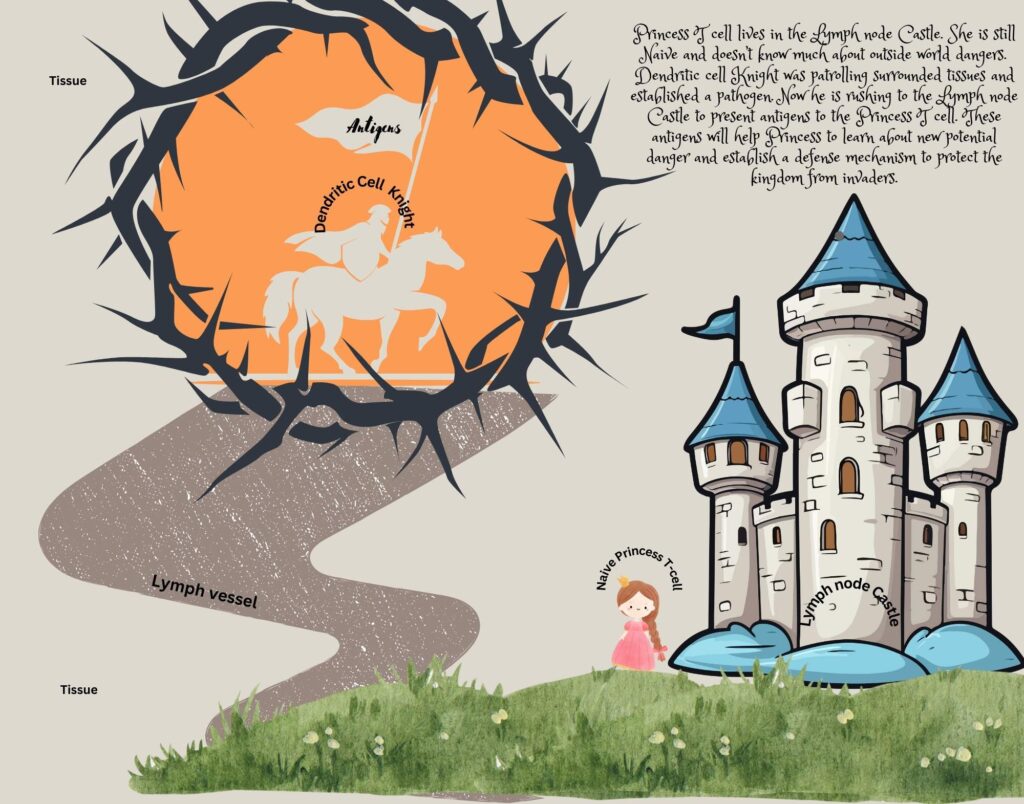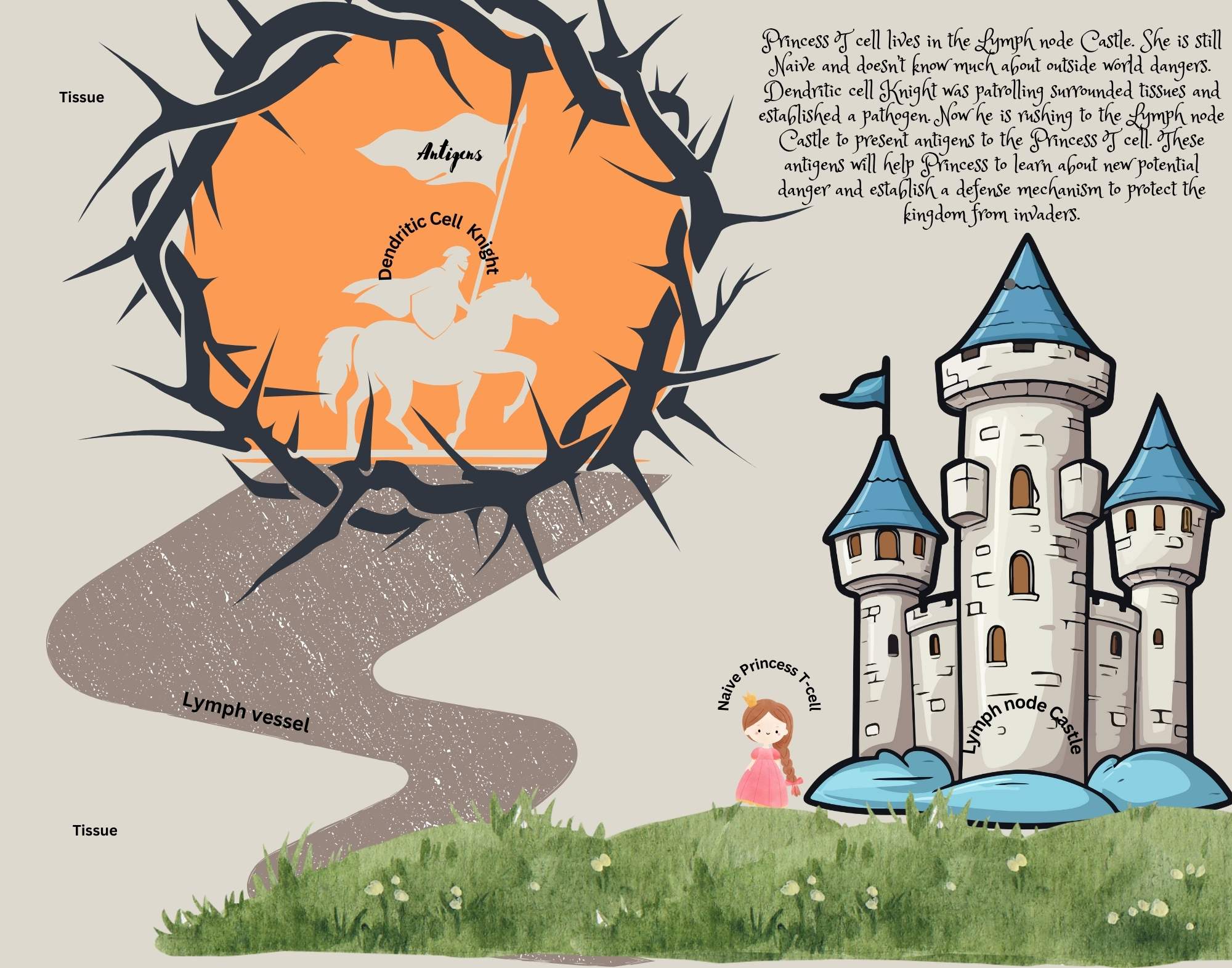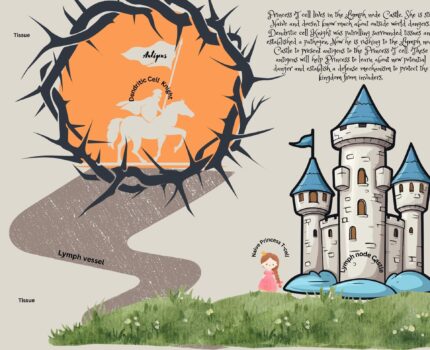When I start learning more about dendritic cells, I couldn’t help but think about them like they are honorable knights that are running around in our body, monitoring the tissues, battling pathogens and heading to the lymph nodes to present potential dangers to the lymph node residents. Their population is broad, diverse but also exclusive. Their main job is to protect our body at any cost, even sacrificing their own life. They can travel to the large distances or be a part of one tissue or organ and serve its duty there. It seems to me like a great resembles to a medieval knight. And then we have T cells that wait for dendritic cells to present them with pathogens. They stay in lymph nodes like princesses in the castles waiting for their knights to arrive and tell them about outside world. I find some humor there that T cells that are yet to be exposed to the antigens are called Naïve. It pushed me more towards creating the setting where a T cell is depicted as a princess that awaits the return of her knight. After she will be exposed to pathogen, she will mature and no longer be called Naïve. She will grow into a potential queen, able of battling intruders by activating her army of B cells. But for now, she just waits for the knight to return from the battlefield. And he is heading to the castle, proudly displaying the antigens he captured ,possibly in a bloody fight.



When I start learning more about dendritic cells, I couldn’t help but think about them like they are honorable knights that are running around in our body, monitoring the tissues, battling pathogens and heading to the lymph nodes to present potential dangers to the lymph node residents. Their population is broad, diverse but also exclusive. Their main job is to protect our body at any cost, even sacrificing their own life. They can travel to the large distances or be a part of one tissue or organ and serve its duty there. It seems to me like a great resembles to a medieval knight. And then we have T cells that wait for dendritic cells to present them with pathogens. They stay in lymph nodes like princesses in the castles waiting for their knights to arrive and tell them about outside world. I find some humor there that T cells that are yet to be exposed to the antigens are called Naïve. It pushed me more towards creating the setting where a T cell is depicted as a princess that awaits the return of her knight. After she will be exposed to pathogen, she will mature and no longer be called Naïve. She will grow into a potential queen, able of battling intruders by activating her army of B cells. But for now, she just waits for the knight to return from the battlefield. And he is heading to the castle, proudly displaying the antigens he captured ,possibly in a bloody fight.
Now I would like to share what I have discovered about dendric cells not in a fairy tale but scientific community.
The first mention of dendritic cells was from 1868. A German medical student, Paul Langerhans, noticed some cells that he initially thought were neurons because of the long dendrites. Only in 1973 their existence was confirmed by two Canadian scientists, Ralph Steinmann and Zanvil Cohn.
Dendritic cells represent a very complex cell population that differ in appearance and location but have a major role in the immunity because of its ability to initiate and direct immune response (Solano-Galvez et al., 2018). They are able to capture antigens by endocytosis, process them and present them to naïve T cells. To carry out these tasks they have to be available to travel to the site of inflammation and afterwards to the lymph nodes where they are going to present T cells with antigens. Dendritic cells claim residency through out the body. They constantly monitor the surroundings for foreign antigens. They recognize them by specialized receptors on their surface known as “ pattern-recognition receptors”. The receptors detect and bind different types of components on the microbial surface, which is distinct from the host. After endocytosis, dendritic cells display antigens on their surface and travel to the nearest lymph node to present them to the T cells. After they capture antigen , they start to mature and become professional antigen-presenting cells (Zana et al.,2021).However they are also responsible for maintaining a steady immune response by constantly sampling local tissues and particles and again presenting them to the lymph node residents. This process helps our body to maintain an immune balance and not to activate immune response where it’s not needed. These abilities lead to the increased interest in dendritic cells in recent years. Scientist are trying to find a way to manipulate dendritic cells in order to use them for vaccines and cancer treatment because of their role in the immune responses. The difficulty arises in their complexity. All dendritic cells originate from bone marrow, but can have lymphoid or myeloid precursors. They also can be conventional or plasmacytoid (Solano-Galvez et al.,2018). They will differ in specialties and appearance. For example , plasmacytoid DCs are practically absent in healthy tissue; however during inflammation they are rapidly recruited. Another differentiation would be between migratory and resident dendritic cells. Non-migratory, also called lymphoid DCs are residents of lymphoid tissues(lymph nodes and spleen) and don’t travel, in comparison with migratory dendritic cells that can travel around other tissues and return to lymph nodes when needed. According to Chan et al.,2023 , the immune regulatory function of DCs is strictly controlled by their distribution as well as by cytokines, chemokines, and transcriptional programming. These factors work in conjunction to determine whether DCs exert an immunosuppressive or immune-activating function. Therefore, understanding the molecular signals involved in DC-dependent immunoregulation is crucial in providing insight into the generation of organismal immunity and revealing potential clinical applications of DCs.
https://humanap.community.uaf.edu/2024/04/22/alcoholism-and-the-effects-on-the-human-body/
My parter was Miranda Hacker. The title of her project was Alcoholism and the effects on the human body. I was not able to leave a comment under her project and was advised to leave the comment with the link to her project here.
For her project Miranda chose to describe effects of alcoholism on the human body. It is an overall summary with drawings of the organs involved and a short description. First, I would like to praise the depiction of the organs. The drawings are very nice and clear. You are a good artist, Miranda! As of what I have learned from this project , I can state that alcoholism has a major effect on our wellbeing.
It brings a negative outcome to major organs or organ systems and consequences very from dry eyes to cancer and death. It effects heart and the outcomes include high blood pressure, edema, stroke, tachycardia, heart attack and heart failure. Excessive drinking may result in kidney problems. These include inflammation, declined filtration and eventually kidney failure. Brain is another major organ that will face a significant decline in its functions. Memory loss, speech impairment, coordination loss, slow thinking, seizures are all could be results of alcohol abuse. Both, female and male reproductive systems are effected by severe drinking. For males it might result in erectile disfunction, infertility, reduced secondary sex characteristics and lowered libido. For females this could include irregularity or complete loss of menstrual cycle, early menopause, miscarriage or infertility. Miranda’s project also states that the most damaged organ in alcoholics is liver. Abuse of alcohol may result in fibrosis, cirrhosis and eventually liver failure.
To summarize all described above I can make a conclusion that alcoholism is a very dangerous habit that will have major consequences on our life, eventually downgrading our health to a very poor state.